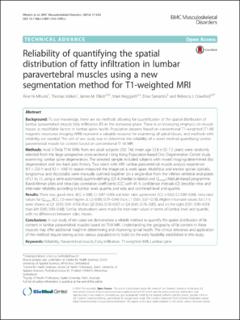Bitte benutzen Sie diese Kennung, um auf die Ressource zu verweisen:
https://doi.org/10.21256/zhaw-2725| Publikationstyp: | Beitrag in wissenschaftlicher Zeitschrift |
| Art der Begutachtung: | Peer review (Publikation) |
| Titel: | Reliability of quantifying the spatial distribution of fatty infiltration in lumbar paravertebral muscles using a new segmentation method for T1-weighted MRI |
| Autor/-in: | Ni Mhuiris, Áine Volken, Thomas Elliott, James Matthew Hoggarth, Mark Samartzis, Dino Crawford, Rebecca |
| DOI: | 10.21256/zhaw-2725 10.1186/s12891-016-1090-z |
| Erschienen in: | BMC Musculoskeletal Disorders |
| Band(Heft): | 17 |
| Heft: | 1 |
| Seite(n): | 234 |
| Seiten bis: | 240 |
| Erscheinungsdatum: | 27-Mai-2016 |
| Verlag / Hrsg. Institution: | BioMed Central |
| ISSN: | 1471-2474 |
| Sprache: | Deutsch |
| Fachgebiet (DDC): | 571: Physiologie und verwandte Themen |
| Zusammenfassung: | Background: To our knowledge, there are no methods allowing for quantification of the spatial distribution of lumbar paravertebral muscle fatty infiltration (FI) in the transverse plane. There is an increasing emphasis on muscle tissues as modifiable factors in lumbar spine health. Population datasets based on conventional T1-weighted (T1-W) magnetic resonance imaging (MRI) represent a valuable resource for examining all spinal tissues, and methods with reliability are needed. The aim of our study was to determine the reliability of a novel method quantifying lumbar paravertebral muscle fat content based on conventional T1-W MRI. Methods: Axial 3-Tesla T1W MRIs from ten adult subjects (3W, 7M; mean age 52.8 ± SD 7.2 years) were randomly selected from the large prospective cross-sectional Hong Kong Population-based Disc Degeneration Cohort study examining lumbar spine degeneration. The selected sample included subjects with mixed imaging-determined disc degeneration and low back pain history. Two raters with MRI lumbar paravertebral muscle analysis experience (R1 > 250 h and R2 > 1000 h) repeat-measured the image-set a week apart. Multifidus and erector spinae (spinalis, longissimus and iliocostalis) were manually outlined together on a single-slice from the inferior vertebral end-plates of L1 to L5 using a semi-automated, quartile-defining (Q1-4 (medial to lateral) and Qmean) MatLab-based programme. Bland-Altman plots and intra-class correlation coefficients (ICC) with 95 % confidence intervals (CI) describe intra- and inter-rater reliability according to lumbar level, quartile, and side, and combined level and quartile. Results: There was good intra- (ICC = 0.88; CI: 0.87-0.90) and inter-rater agreement (ICC = 0.82; CI: 0.80-0.84). Intra-rater values for Qmean (ICC; CI) were higher at L5 (0.89; 0.79-0.94) than L1 (0.61; 0.37-0.78). Higher intra-rater values for L1-5 were shown at Q1 (0.93; 0.91-0.95) than Q3 (0.83; 0.78-0.87) or Q4 (0.81; 0.76-0.85), and on the right (0.91; 0.90-0.93) than left (0.85; 0.83-0.88). Similar observations were made for inter-rater values in terms of lumbar level and quartile, with no differences between sides shown. Conclusions: In our study of ten cases we demonstrate a reliable method to quantify the spatial distribution of fat content in lumbar paravertebral muscles based on T1W MRI. Understanding the geography of fat content in these muscles may offer additional insight in determining and improving spinal health. The clinical relevance and application of this method require testing across various populations to build on the early feasibility established in this study. |
| URI: | https://digitalcollection.zhaw.ch/handle/11475/9974 |
| Volltext Version: | Publizierte Version |
| Lizenz (gemäss Verlagsvertrag): | CC BY 4.0: Namensnennung 4.0 International |
| Departement: | Gesundheit |
| Organisationseinheit: | Institut für Public Health (IPH) |
| Enthalten in den Sammlungen: | Publikationen Gesundheit |
Dateien zu dieser Ressource:
| Datei | Beschreibung | Größe | Format | |
|---|---|---|---|---|
| 2016_Volken_Reliability of quantifying_BMC Musculoskeletal Disorders.pdf | 842.38 kB | Adobe PDF |  Öffnen/Anzeigen |
Zur Langanzeige
Ni Mhuiris, Á., Volken, T., Elliott, J. M., Hoggarth, M., Samartzis, D., & Crawford, R. (2016). Reliability of quantifying the spatial distribution of fatty infiltration in lumbar paravertebral muscles using a new segmentation method for T1-weighted MRI. BMC Musculoskeletal Disorders, 17(1), 234–240. https://doi.org/10.21256/zhaw-2725
Ni Mhuiris, Á. et al. (2016) ‘Reliability of quantifying the spatial distribution of fatty infiltration in lumbar paravertebral muscles using a new segmentation method for T1-weighted MRI’, BMC Musculoskeletal Disorders, 17(1), pp. 234–240. Available at: https://doi.org/10.21256/zhaw-2725.
Á. Ni Mhuiris, T. Volken, J. M. Elliott, M. Hoggarth, D. Samartzis, and R. Crawford, “Reliability of quantifying the spatial distribution of fatty infiltration in lumbar paravertebral muscles using a new segmentation method for T1-weighted MRI,” BMC Musculoskeletal Disorders, vol. 17, no. 1, pp. 234–240, May 2016, doi: 10.21256/zhaw-2725.
NI MHUIRIS, Áine, Thomas VOLKEN, James Matthew ELLIOTT, Mark HOGGARTH, Dino SAMARTZIS und Rebecca CRAWFORD, 2016. Reliability of quantifying the spatial distribution of fatty infiltration in lumbar paravertebral muscles using a new segmentation method for T1-weighted MRI. BMC Musculoskeletal Disorders. 27 Mai 2016. Bd. 17, Nr. 1, S. 234–240. DOI 10.21256/zhaw-2725
Ni Mhuiris, Áine, Thomas Volken, James Matthew Elliott, Mark Hoggarth, Dino Samartzis, and Rebecca Crawford. 2016. “Reliability of quantifying the spatial distribution of fatty infiltration in lumbar paravertebral muscles using a new segmentation method for T1-weighted MRI.” BMC Musculoskeletal Disorders 17 (1): 234–40. https://doi.org/10.21256/zhaw-2725.
Ni Mhuiris, Áine, et al. “Reliability of quantifying the spatial distribution of fatty infiltration in lumbar paravertebral muscles using a new segmentation method for T1-weighted MRI.” BMC Musculoskeletal Disorders, vol. 17, no. 1, May 2016, pp. 234–40, https://doi.org/10.21256/zhaw-2725.
Alle Ressourcen in diesem Repository sind urheberrechtlich geschützt, soweit nicht anderweitig angezeigt.